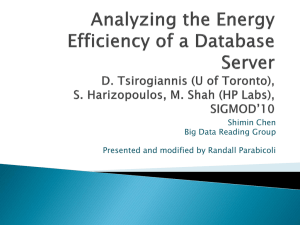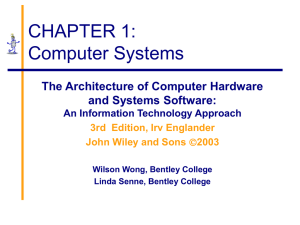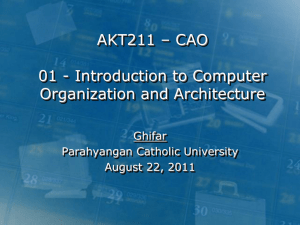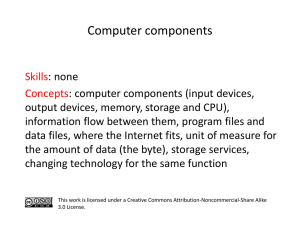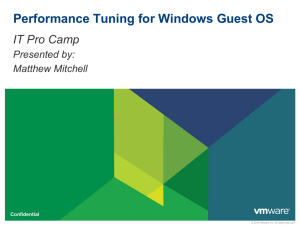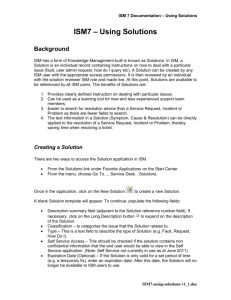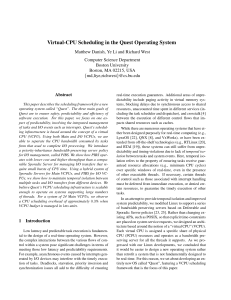Some Issues in Modeling VMware ESX Server
advertisement
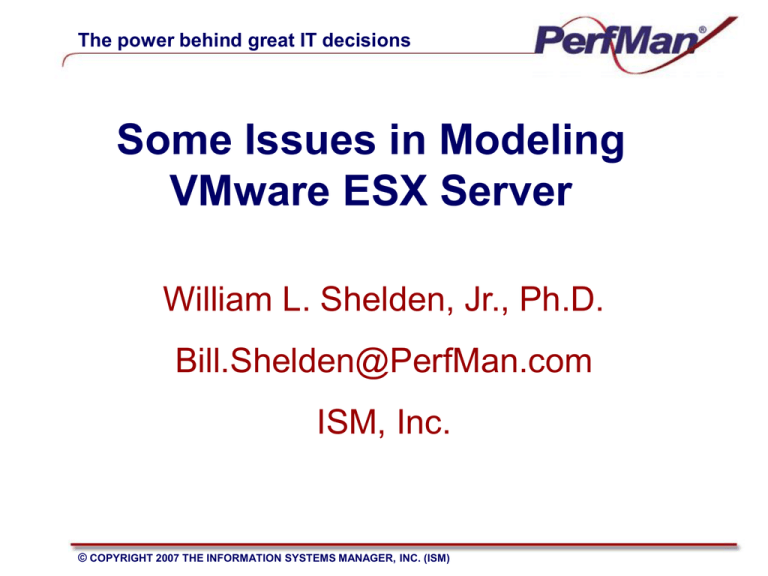
The power behind great IT decisions Some Issues in Modeling VMware ESX Server William L. Shelden, Jr., Ph.D. Bill.Shelden@PerfMan.com ISM, Inc. © COPYRIGHT 2007 THE INFORMATION SYSTEMS MANAGER, INC. (ISM) Abstract Some Issues in Modeling VMware ESX Server Two approaches to modeling VMware ESX Server are presented. The focus is on how the two model designs reflect the impact of changing the number of virtual CPUs in virtual machines running under VMware ESX Server from the point-of-view of CPU throughputs and response times. Some benchmark results appearing recently in the literature are used to validate the preferred model design. Some problems with the interpretation and modeling of virtual machine CPU utilizations as measured by Windows guest operating systems are also discussed. © COPYRIGHT 2007 THE INFORMATION SYSTEMS MANAGER, INC. (ISM) Topics • The first model and its problems. • The second model and why it is better. • Validating the second model. Bolker and Ding paper Open v. Closed benchmarks/models Windows CPU Utilizations are problematic • Modeling changes to the number of virtual CPUs in Virtual Machines • Additional VMware ESX Server Modeling Challenges CPU affinity Hyperthreading © COPYRIGHT 2007 THE INFORMATION SYSTEMS MANAGER, INC. (ISM) First Model (CMG 2005) VM2 Delay VM1 Delay CPU Queue 2 Job Classes Server with 4 pCPUs © COPYRIGHT 2007 THE INFORMATION SYSTEMS MANAGER, INC. (ISM) •One for each VM •Pop = No. vCPUs •Target Util/Tput Two Problems with the First Model • Throughput cannot change The model is solved iteratively. After each iteration, the basic equation is for each VM is: • N = Tput x (STCPU + QTCPU + Z) This becomes… • vCPUs = Tput x (STCPU + QTCPU + Z) • What happens if user changes vCPUs? Z is is recomputed after each iteration to achieve the target utilization (i.e. throughput), so the throughput cannot change (unless the target utilization is changed.) And, Z is a workload characteristic; it should not change. • The model does not reflect queueing for virtual CPUs within the guest operating systems. Fewer vCPUs will always be better! © COPYRIGHT 2007 THE INFORMATION SYSTEMS MANAGER, INC. (ISM) Two Sources of CPU Delay Without the vCPU Delay, 25 second model looks worse 20 15 pCPU Delay vCPU Delay CPU Service 10 5 0 Base More vCPUs © COPYRIGHT 2007 THE INFORMATION SYSTEMS MANAGER, INC. (ISM) Second Model VM2 Delay VM1 Delay Allocate vCPU Release vCPU CPU Queue Release vCPU Allocate vCPU Server with 4 pCPUs © COPYRIGHT 2007 THE INFORMATION SYSTEMS MANAGER, INC. (ISM) 2 Job Classes •One for each VM •Pop = WinMPL •Target Util/Tput Why is the Second Model better? • Throughput can change We still have for each VM: • N = Tput x (STCPU + QTCPU + Z), but now it looks like • WinMPL = Tput x (STCPU + QTCPU + Z) • If the user changes vCPUs for a particular VM: It changes the number of ‘tokens’ (vCPUs) available at the Allocate node in the model for the particular VM Model is executed once with Z fixed from Base model, so throughput will change • Can track delay for virtual CPUs and delay for physical CPUs separately in the simulation © COPYRIGHT 2007 THE INFORMATION SYSTEMS MANAGER, INC. (ISM) The Bolker & Ding Paper Virtual performance won’t do: Capacity planning for virtual systems • Describes a series of benchmarks: VMware ESX Server running on dual processor Two guests running Windows 2000 (Bermuda and Largo) Load generator forced load at specified utilization to each VM by sending a Poisson stream of computation intensive jobs (finding logarithms) Seven runs with Bermuda at 25% and Largo varying from 20% to 50% by 5% Used CPU affinity so two guests competed with each other for the same processor but did not compete with the manager No hyperthreading © COPYRIGHT 2007 THE INFORMATION SYSTEMS MANAGER, INC. (ISM) Paper Results © COPYRIGHT 2007 THE INFORMATION SYSTEMS MANAGER, INC. (ISM) Bermuda Results Bermuda Results from Closed Model 70 60 50 40 30 20 10 0 20% 25% 30% 35% 40% 45% Largo % Utilization throughput utilization (guest view) utilization (manager view) response time total utilization (manager view) © COPYRIGHT 2007 THE INFORMATION SYSTEMS MANAGER, INC. (ISM) 50% Largo Results Largo Results from Closed Model 70 60 50 40 30 20 10 0 20% 25% 30% 35% 40% 45% Largo % Utilization throughput utilization (guest view) utilization (manager view) response time total utilization (manager view) © COPYRIGHT 2007 THE INFORMATION SYSTEMS MANAGER, INC. (ISM) 50% Modeling the Bolker and Ding Benchmarks • Benchmarks set up with an open source • Therefore, the best model to use to model the benchmark is an open model • But queue lengths in an open model are not bounded • Therefore, an open model will in general give higher mean queue times © COPYRIGHT 2007 THE INFORMATION SYSTEMS MANAGER, INC. (ISM) Open vs. Closed Model CPU Response Times Closed Model (100 Threads) CPU Response Times Open Model Mean Queue Time 0.4 0.2 45% 50% 55% 60% 65% 69% 74% 80% 85% 6 5 0.6 4 0.4 3 2 0.2 0.0 1 45% 50% 55% 59% 64% 69% 73% 78% 82% CPU Service Time 0.6 4 0.4 3 2 0.2 1 45% 50% 55% 59% 64% 68% 73% 78% 82% 0 CPU Queue Time CPU Queue Length 0.8 6 5 0.6 4 0.4 3 2 0.2 0.0 1 45% 50% 55% 59% 65% 69% 73% 78% 82% % Utilization © COPYRIGHT 2007 THE INFORMATION SYSTEMS MANAGER, INC. (ISM) % Utilization 0 Mean Number 5 Seconds 6 Mean Number Seconds CPU Response Times Closed Model (150 Threads) CPU Queue Length 0.8 0.0 0 % Utilization CPU Response Times Closed Model (125 Threads) CPU Queue Time CPU Queue Length 0.8 % Utilization CPU Service Time CPU Queue Time Mean Number 0.6 6 5 4 3 2 1 0 Mean Number Seconds 0.8 0.0 CPU Service Time CPU Queue Length Seconds Mean Service Time Open v. Closed Model Summarized Open v. Closed Model Summary Open Closed P=100 Closed P=125 Closed P=150 0.8 0.7 0.6 Seconds 0.5 0.4 0.3 0.2 0.1 0 1 2 3 4 5 6 Model Run © COPYRIGHT 2007 THE INFORMATION SYSTEMS MANAGER, INC. (ISM) 7 8 9 Modeling changes to vCPUs • VMware ESX Server System: Server had 4 physical CPUs (pCPUs) 13 Virtual machines (VM) No VM used more than about 40% of a single pCPU Each VM had 2 virtual CPUs (vCPUs) • What would be impact of reducing the number of vCPUs from 2 to 1 in each VM? © COPYRIGHT 2007 THE INFORMATION SYSTEMS MANAGER, INC. (ISM) Modeling changes to vCPUs © COPYRIGHT 2007 THE INFORMATION SYSTEMS MANAGER, INC. (ISM) VMware ESX Server Dispatching • Dispatch when Ready Dispatch a vCPU when it has work to do Not how VMware ESX Server dispatches • Dispatch in Pairs Dispatch all of the vCPUs in the VM together This is how VMware ESX Server dispatches © COPYRIGHT 2007 THE INFORMATION SYSTEMS MANAGER, INC. (ISM) Using the Second Model © COPYRIGHT 2007 THE INFORMATION SYSTEMS MANAGER, INC. (ISM) Additional Modeling Issues • Model CPU Affinity • Model Hyperthreading © COPYRIGHT 2007 THE INFORMATION SYSTEMS MANAGER, INC. (ISM)



